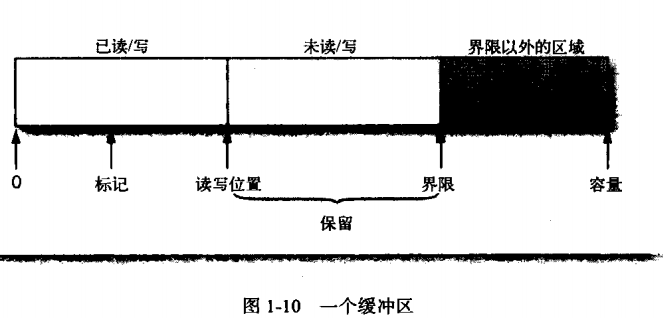JAVA NIO——Buffer和FileChannel




Java NIO和IO的主要区别
| IO | NIO |
| 面向流 | 面向缓冲 |
| 阻塞IO | 非阻塞IO |
| 无 | 选择器 |
示例:
1 import java.io.FileInputStream; 2 import java.io.FileOutputStream; 3 import java.io.IOException; 4 import java.io.UnsupportedEncodingException; 5 import java.nio.ByteBuffer; 6 import java.nio.channels.FileChannel; 7 import java.nio.charset.Charset; 8 9 public class BufferToText { 10 11 public static void main(String[] args) { 12 try { 13 //--以系统默认编码方式写文件 14 FileChannel fc = new FileOutputStream("data2.txt").getChannel(); 15 fc.write(ByteBuffer.wrap("测试字符".getBytes())); 16 fc.close(); 17 18 //--读文本 19 fc = new FileInputStream("data2.txt").getChannel(); 20 ByteBuffer buff = ByteBuffer.allocate(1024); 21 fc.read(buff); 22 buff.flip(); 23 //显示乱码,采用默认的编码方式(UTF-16BE)将ByteBuffer转换成CharBuffer 24 System.out.println(buff.asCharBuffer()); 25 buff.rewind();//准备重读 26 27 //当前系统默认编码方式 28 String encoding = System.getProperty("file.encoding"); 29 //下面我们使用系统默认的编码方式(GBK)将ByteBuffer转换成CharBuffer 30 System.out.println("Decoded using " + encoding + ": " 31 + Charset.forName(encoding).decode(buff));//显示正常,因为写入与读出时采用相同编码方式 32 33 //--或者,先以UTF-16BE编码后再写文件 34 fc = new FileOutputStream("data2.txt").getChannel(); 35 fc.write(ByteBuffer.wrap("测试字符".getBytes("UTF-16BE"))); 36 fc.close(); 37 // 再尝试读 38 fc = new FileInputStream("data2.txt").getChannel(); 39 buff.clear(); 40 fc.read(buff); 41 buff.flip(); 42 //显示正常,可见asCharBuffer()方式是以UTF-16BE解码的 43 System.out.println(buff.asCharBuffer()); 44 45 //--也可直接通过CharBuffer写也是可以的 46 fc = new FileOutputStream("data2.txt").getChannel(); 47 buff = ByteBuffer.allocate(8);//UTF-16编码时每个字符占二字节,所以需四个 48 //将ByteBuffer转换成CharBuffer后再写 49 buff.asCharBuffer().put("测试字符"); 50 fc.write(buff); 51 fc.close(); 52 //读显示 53 fc = new FileInputStream("data2.txt").getChannel(); 54 buff.clear(); 55 fc.read(buff); 56 buff.flip(); 57 //同时也采用默认的转换方式asCharBuffer将ByteBuffer转换成CharBuffer 58 System.out.println(buff.asCharBuffer());//显示正常 59 } catch (UnsupportedEncodingException e) { 60 e.printStackTrace(); 61 } catch (IOException e) { 62 e.printStackTrace(); 63 } 64 } 65 }






